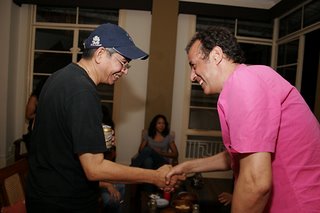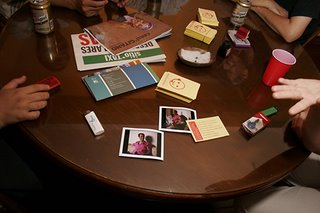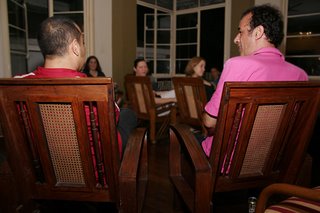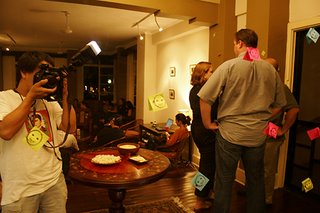 TALK TO ME BABY!
TALK TO ME BABY!And so it came to pass that the third Artist's Talk at The Living Room came to be. And if I must say so myself, it was perhaps the most successful one so far. The artist of the evening was the current artist-in-residence, Miss Jenifer Wofford, a Fil-Am multi-media artist from Oakland, California, US of A (pictured above chatting with yours truly.)
 It was one of the best attended talks, too. The crowd topped off at - ooh, say, around twenty-three. Naturally, that number includes our dear helper, Susan (pictured above, peeking behind Jenifer who is beside my wife Tesa (L), the TLR technical director Denis Lagdameo (R)).
It was one of the best attended talks, too. The crowd topped off at - ooh, say, around twenty-three. Naturally, that number includes our dear helper, Susan (pictured above, peeking behind Jenifer who is beside my wife Tesa (L), the TLR technical director Denis Lagdameo (R)).
 Fellow bloggers, Micketymoc (above on R) and his better half, Minette, as well as Watergirl and her friend, Ashani arrived bright and early. Meanwhile, bringing up the rear at the end of the talk were Susanne Lenz, Tilman Baumgartel, upstairs neighbors Butch, and Coco and Baby of Lumiere. Surreal moment of the evening: PR maven Junjun Poblador swanning in with recently outed Pinoy Brother survivor, Rustom Padilla. I know, wha...why is he here? I really don't know. Just wished I took a picture, though. It isn't very often when post-modern art discourse and Philippine showbiz meet and match.
Fellow bloggers, Micketymoc (above on R) and his better half, Minette, as well as Watergirl and her friend, Ashani arrived bright and early. Meanwhile, bringing up the rear at the end of the talk were Susanne Lenz, Tilman Baumgartel, upstairs neighbors Butch, and Coco and Baby of Lumiere. Surreal moment of the evening: PR maven Junjun Poblador swanning in with recently outed Pinoy Brother survivor, Rustom Padilla. I know, wha...why is he here? I really don't know. Just wished I took a picture, though. It isn't very often when post-modern art discourse and Philippine showbiz meet and match.
 So after a rather OK sunset on Manila Bay (there have been better ones), we all had a few beers and watched slides of her early sculptures (above). Afterwards, there was a screening of her video works, Cucaracha Motel, Flipflop on a stick, and Chicksilog. Some of the topics discussed that evening were: sculpture vis-a-vis two-dimensional work, the state of art education in the California public school system, feminism, the Filipino diaspora, nurses, her mother, my mother, and someone else's mother, and of course, the joys of her collaborative work with fellow Fil-Ams Eliza Barrios and Reanne Estrada in the renegade performance art trio, Mail Order Brides. It was a good talk, deep but not too pretentious; provocative but non-confrontational.
So after a rather OK sunset on Manila Bay (there have been better ones), we all had a few beers and watched slides of her early sculptures (above). Afterwards, there was a screening of her video works, Cucaracha Motel, Flipflop on a stick, and Chicksilog. Some of the topics discussed that evening were: sculpture vis-a-vis two-dimensional work, the state of art education in the California public school system, feminism, the Filipino diaspora, nurses, her mother, my mother, and someone else's mother, and of course, the joys of her collaborative work with fellow Fil-Ams Eliza Barrios and Reanne Estrada in the renegade performance art trio, Mail Order Brides. It was a good talk, deep but not too pretentious; provocative but non-confrontational.
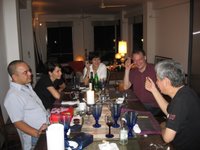 So after hoo-ing and hah-ing and way too much posing for photos, things finally wrapped up at around ten pm. Some headed off to the Preview Rock Glam party at the Cultural Center of the Philippines, while most of us just retired upstairs for some impromptu pasta.
So after hoo-ing and hah-ing and way too much posing for photos, things finally wrapped up at around ten pm. Some headed off to the Preview Rock Glam party at the Cultural Center of the Philippines, while most of us just retired upstairs for some impromptu pasta.
All in all, I can say art is alive and well in downtown Manila. Hope to see more of you out here at the next artist talk.
 It was one of the best attended talks, too. The crowd topped off at - ooh, say, around twenty-three. Naturally, that number includes our dear helper, Susan (pictured above, peeking behind Jenifer who is beside my wife Tesa (L), the TLR technical director Denis Lagdameo (R)).
It was one of the best attended talks, too. The crowd topped off at - ooh, say, around twenty-three. Naturally, that number includes our dear helper, Susan (pictured above, peeking behind Jenifer who is beside my wife Tesa (L), the TLR technical director Denis Lagdameo (R)). Fellow bloggers, Micketymoc (above on R) and his better half, Minette, as well as Watergirl and her friend, Ashani arrived bright and early. Meanwhile, bringing up the rear at the end of the talk were Susanne Lenz, Tilman Baumgartel, upstairs neighbors Butch, and Coco and Baby of Lumiere. Surreal moment of the evening: PR maven Junjun Poblador swanning in with recently outed Pinoy Brother survivor, Rustom Padilla. I know, wha...why is he here? I really don't know. Just wished I took a picture, though. It isn't very often when post-modern art discourse and Philippine showbiz meet and match.
Fellow bloggers, Micketymoc (above on R) and his better half, Minette, as well as Watergirl and her friend, Ashani arrived bright and early. Meanwhile, bringing up the rear at the end of the talk were Susanne Lenz, Tilman Baumgartel, upstairs neighbors Butch, and Coco and Baby of Lumiere. Surreal moment of the evening: PR maven Junjun Poblador swanning in with recently outed Pinoy Brother survivor, Rustom Padilla. I know, wha...why is he here? I really don't know. Just wished I took a picture, though. It isn't very often when post-modern art discourse and Philippine showbiz meet and match. So after a rather OK sunset on Manila Bay (there have been better ones), we all had a few beers and watched slides of her early sculptures (above). Afterwards, there was a screening of her video works, Cucaracha Motel, Flipflop on a stick, and Chicksilog. Some of the topics discussed that evening were: sculpture vis-a-vis two-dimensional work, the state of art education in the California public school system, feminism, the Filipino diaspora, nurses, her mother, my mother, and someone else's mother, and of course, the joys of her collaborative work with fellow Fil-Ams Eliza Barrios and Reanne Estrada in the renegade performance art trio, Mail Order Brides. It was a good talk, deep but not too pretentious; provocative but non-confrontational.
So after a rather OK sunset on Manila Bay (there have been better ones), we all had a few beers and watched slides of her early sculptures (above). Afterwards, there was a screening of her video works, Cucaracha Motel, Flipflop on a stick, and Chicksilog. Some of the topics discussed that evening were: sculpture vis-a-vis two-dimensional work, the state of art education in the California public school system, feminism, the Filipino diaspora, nurses, her mother, my mother, and someone else's mother, and of course, the joys of her collaborative work with fellow Fil-Ams Eliza Barrios and Reanne Estrada in the renegade performance art trio, Mail Order Brides. It was a good talk, deep but not too pretentious; provocative but non-confrontational. So after hoo-ing and hah-ing and way too much posing for photos, things finally wrapped up at around ten pm. Some headed off to the Preview Rock Glam party at the Cultural Center of the Philippines, while most of us just retired upstairs for some impromptu pasta.
So after hoo-ing and hah-ing and way too much posing for photos, things finally wrapped up at around ten pm. Some headed off to the Preview Rock Glam party at the Cultural Center of the Philippines, while most of us just retired upstairs for some impromptu pasta.All in all, I can say art is alive and well in downtown Manila. Hope to see more of you out here at the next artist talk.








